Analysis Ready Data of the Chinese GaoFen Satellite Data
Abstract
:1. Introduction
2. Processing Procedures and Tile Structure for the GF-1 ARD
2.1. Input GF1/WFV Data and Processing
2.1.1. Geometric Normalization
2.1.2. Radiometric Normalization
2.1.3. Atmospheric Correction
2.2. The ARD Tiling and Projection
3. ARD Contents
3.1. ARD Filename Convention, Format, Metadata and Documentation
3.2. The Viewing and Solar Geometry Dataset
3.3. ARD TOA Reflectance Dataset
3.4. ARD Surface Reflectance Dataset
3.5. ARD Quality Assessment Bands
3.6. The Preliminary Application of the GF1-WFV ARD
3.7. ARD Future Revision Schedule
4. Discussion
5. Conclusions
Author Contributions
Funding
Acknowledgments
Conflicts of Interest
References
- Woodcock, C.E.; Allen, R.; Anderson, M.; Belward, A.; Bindschadler, R.; Cohen, W.; Gao, F.; Goward, S.N.; Helder, D.; Helmer, E.; et al. Free access to Landsat imagery. Science 2008, 320, 1011. [Google Scholar] [CrossRef] [PubMed]
- Wulder, M.A.; White, J.C.; Loveland, T.R.; Woodcock, C.E.; Roy, D.P. The global Landsat archive: Status, consolidation, and direction. Remote Sens. Environ. 2016, 185, 271–283. [Google Scholar] [CrossRef] [Green Version]
- Roy, D.P.; Ju, J.; Kline, K.; Scaramuzza, P.L.; Kovalskyy, V.; Hansen, M.; Loveland, T.R.; Vermote, E.; Zhang, C. Web-enabled Landsat data (weld): Landsat etm+ composited mosaics of the conterminous united states. Remote Sens. Environ. 2009, 114, 35–49. [Google Scholar] [CrossRef]
- Roy, D.P.; Wulder, M.; Loveland, T.R.; Woodcock, C.; Allen, R.; Anderson, M.; Helder, D.; Irons, J.; Johnson, D.; Kennedy, R.; et al. Landsat-8: Science and product vision for terrestrial global change research. Remote Sens. Environ. 2014, 145, 154–172. [Google Scholar] [CrossRef] [Green Version]
- Lewis, A.; Oliver, S.; Lymburner, L.; Evans, B.; Wyborn, L.; Mueller, N.; Raevksi, G.; Hooke, J.; Woodcock, R.; Sixsmith, J.; et al. The Australian geoscience data cube—Foundations and lessons learned. Remote Sens. Environ. 2017, 202, 276–292. [Google Scholar] [CrossRef]
- Wulder, M.A.; Coops, N.C.; Roy, D.P.; White, J.C.; Hermosilla, T. Land cover 2.0. Int. J. Remote Sens. 2018, 39, 4254–4284. [Google Scholar] [CrossRef] [Green Version]
- Dwyer, J.L.; Roy, D.P.; Sauer, B.; Jenkerson, C.B.; Lymburner, L. Analysis ready data: Enabling analysis of the Landsat archive. Remote Sens. 2018, 10, 1363. [Google Scholar]
- Townshend, J.R.G.; Justice, C.O. The impact of misregistration on change detection. IEEE Trans. Geosci. Remote Sens. 1992, 30, 1054–1060. [Google Scholar] [CrossRef] [Green Version]
- Chander, G.; Helder, D.L.; Aaron, D.; Mishra, N.; Shrestha, A.K. Assessment of spectral, misregistration, and spatial uncertainties inherent in the cross-calibration study. IEEE Trans. Geosci. Remote Sens. 2013, 51, 1282–1296. [Google Scholar] [CrossRef]
- Yang, A.; Zhong, B.; Wu, S.; Liu, Q. Evaluation on radiometric capability of Chinese optical satellite sensors. Sensors 2017, 17, 204. [Google Scholar] [CrossRef] [Green Version]
- Shan, X.; Tang, P.; Hu, C. An automatic geometric precision correction system based on hierarchical registration for HJ-1 A/B CCD images. Int. J. Remote Sens. 2014, 35, 7154–7178. [Google Scholar] [CrossRef]
- Guenther, B.; Xiong, X.; Salomonson, V.V.; Barnes, W.L.; Young, J. On-orbit performance of the earth observing system moderate resolution imaging spectroradiometer; first year of data. Remote Sens. Environ. 2002, 83, 16–30. [Google Scholar] [CrossRef]
- Zhong, B.; Zhang, Y.; Du, T.; Yang, A.; Lv, W.; Liu, Q. Cross-calibration of HJ-1/CCD over a desert site using Landsat ETM+ imagery and ASTER GDEM product. IEEE Trans. Geosci. Remote Sens. 2014, 52, 7247–7263. [Google Scholar] [CrossRef]
- Yang, A.; Zhong, B.; Lv, W.; Wu, S.; Liu, Q. Cross-calibration of GF-1/WFV over a desert site using Landsat-8/OLI imagery and ZY-3/TLC data. Remote Sens. 2015, 7, 10763–10787. [Google Scholar] [CrossRef] [Green Version]
- Yang, A.; Zhong, B.; Wu, S.; Liu, Q. Radiometric Cross-Calibration of GF-4 in Multispectral Bands. Remote Sens. 2017, 9, 232. [Google Scholar] [CrossRef] [Green Version]
- Yang, A.; Zhong, B.; Hu, L.; Wu, S.; Xu, Z.; Wu, H.; Wu, J.; Gong, X.; Wang, H.; Liu, Q. Radiometric cross-calibration of the wide field view camera onboard gaofen-6 in multispectral bands. Remote Sens. 2020, 12, 1037. [Google Scholar] [CrossRef] [Green Version]
- Kaufman, Y.J.; Tanre, D.; Remer, L.A.; Vermote, E.F.; Chu, A.; Holben, B.N. Operational remote sensing of tropospheric aerosol over land EOS moderate resolution imaging spectroradiometer. J. Geophys. Res 1997, 102, 17051–17067. [Google Scholar] [CrossRef]
- Remer, L.A.; Kaufman, Y.J.; Tanré, D.; Mattoo, S.; Chu, D.A.; Martins, J.V.; Li, R.-R.; Ichoku, C.; Levy, R.C.; Kleidman, R.G.; et al. The MODIS aerosol algorithm, products, and validation. J. Atmos. Sci. 2005, 62, 947–973. [Google Scholar] [CrossRef] [Green Version]
- Masek, J.G.; Vermote, E.F.; Saleous, N.E.; Wolfe, R.; Hall, F.G.; Huemmrich, K.F.; Gao, F.; Kutler, J.; Lim, T.-K. A Landsat surface reflectance dataset for North America, 1990–2000. IEEE Geosci. Remote Sens. Lett. 2006, 3, 68–72. [Google Scholar] [CrossRef]
- Ju, J.; Roy, D.P.; Vermote, E.; As Ek, J.M.; Kovalskyy, V. Continental-scale validation of modis-based and ledaps Landsat ETM+ atmospheric correction methods. Remote Sens. Environ. 2012, 122, 175–184. [Google Scholar] [CrossRef] [Green Version]
- Zhong, B.; Wu, S.; Yang, A.; Liu, Q. An improved aerosol optical depth retrieval algorithm for moderate to high spatial resolution optical remotely sensed imagery. Remote Sens. 2017, 9, 555. [Google Scholar] [CrossRef] [Green Version]
- Dubovik, O.; Holben, B.N.; Eck, T.; Smirnov, A.; Slutsker, I. Variability of absorption and optical properties of key aerosol types observed in worldwide locations. J. Atmos. 2002, 59, 590–608. [Google Scholar] [CrossRef]
- Claverie, M.; Vermote, E.F.; Franch, B.; Masek, J.G. Evaluation of the Landsat-5 tm and Landsat-7 ETM+ surface reflectance products. Remote Sens. Environ. 2015, 169, 390–403. [Google Scholar] [CrossRef]
- Lutz, B.; Roy, D.P.; Leff, C.; Lewicki, S.; Chu, A. A review of EOS Terra quality assessment. IEEE Int. Geosci. Remote Sens. Symp. 2000, 5, 2092–2095. [Google Scholar]
- Roy, D.P.; Borak, J.S.; Devadiga, S.; Wolfe, R.E.; Min, Z.; Descloitres, J. The modis land product quality assessment approach. Remote Sens. Environ. 2000, 83, 62–76. [Google Scholar] [CrossRef]
- Bo, Z.; Chen, W.; Wu, S.; Hu, L.; Luo, X.; Liu, Q. A cloud detection method based on relationship between objects of cloud and cloud-shadow for chinese moderate to high resolution satellite imagery. IEEE J. Sel. Top. Appl. Earth Obs. Remote Sens. 2017, 10, 4898–4908. [Google Scholar]
- Forster, B.C. Derivation of atmospheric correction procedures for Landsat MSS with particular reference to urban data. Int. J. Remote Sens. 1984, 5, 799–817. [Google Scholar] [CrossRef]
- Braaten, J.D.; Cohen, W.B.; Yang, Z. Automated cloud and cloud shadow identification in Landsat MSS imagery for temperate ecosystems. Remote Sens. Environ. 2015, 169, 128–138. [Google Scholar] [CrossRef] [Green Version]
- Roy, D.P.; Yan, L. Robust Landsat-based crop time series modelling. Remote Sens. Environ. 2018, 238, 110810. [Google Scholar] [CrossRef]
- Justice, C.O.; Vermote, E.; Townshend, J.; Defries, R.; Roy, D.P.; Hall, D.K.; Salomonson, V.V.; Privette, J.L.; Riggs, G.; Strahler, A.; et al. The moderate resolution imaging spectroradiometer (modis): Land remote sensing for global change research. IEEE Trans. Geosci. Remote Sens. 1998, 36, 1228–1249. [Google Scholar] [CrossRef] [Green Version]
- Storey, J.; Roy, D.P.; Masek, J.; Gascon, F.; Dwyer, J.; Choate, M. A note on the temporary misregistration of Landsat-8 operational land imager (OLI) and Sentinel-2 multi spectral instrument (MSI) imagery. Remote Sens. Environ. 2016, 186, 121–122. [Google Scholar] [CrossRef] [Green Version]
- Zhang, H.K.; Roy, D.P.; Yan, L.; Li, Z.; Huang, H.; Vermote, E.; Skakun, S.; Roger, J.-C. Characterization of Sentinel-2a and Landsat-8 top of atmosphere, surface, and nadir BRDF adjusted reflectance and NDVI differences. Remote Sens. Environ. 2018, 215, 482–494. [Google Scholar] [CrossRef]
- Claverie, M.; Ju, J.; Masek, J.G.; Dungan, J.L.; Vermote, E.F.; Roger, J.-C.; Skakun, S.V.; Justice, C. The harmonized Landsat and Sentinel-2 surface reflectance data set. Remote Sens. Environ. 2018, 219, 145–161. [Google Scholar] [CrossRef]
- Lafrance, B. Observations and Recommendations for the Calibration of Landsat 8 OLI and Sentinel 2 MSI for Improved Data Interoperability. Remote Sens. 2019, 10, 1340. [Google Scholar]
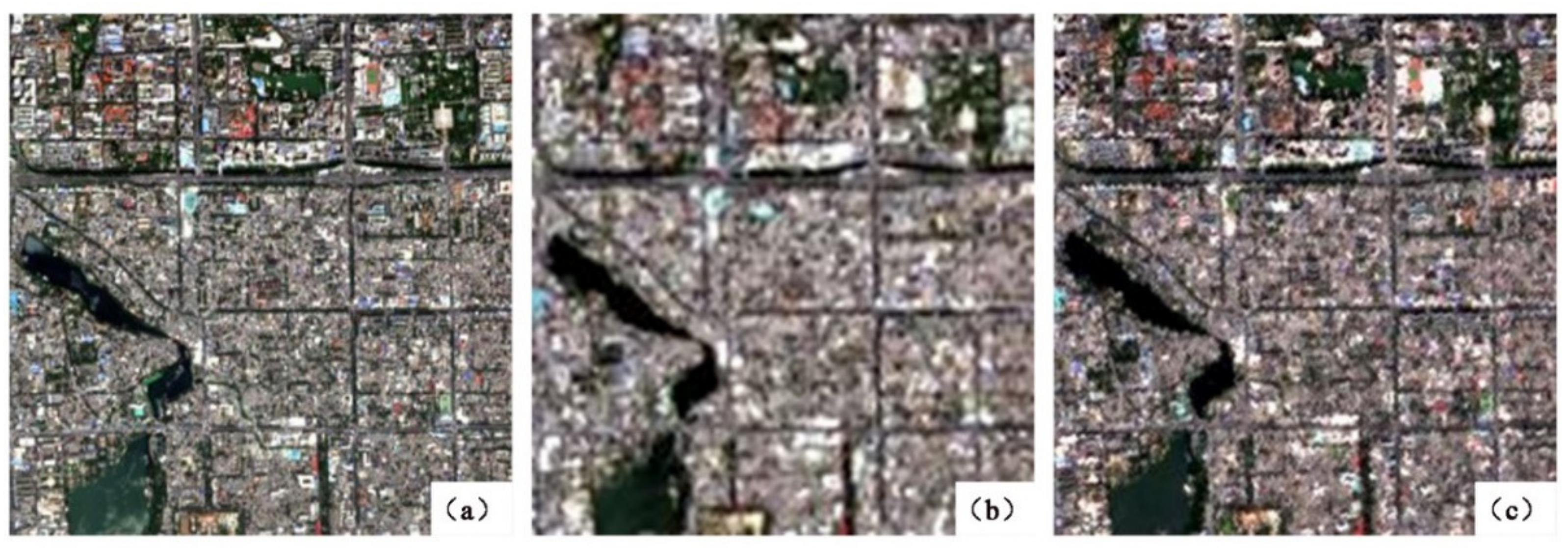
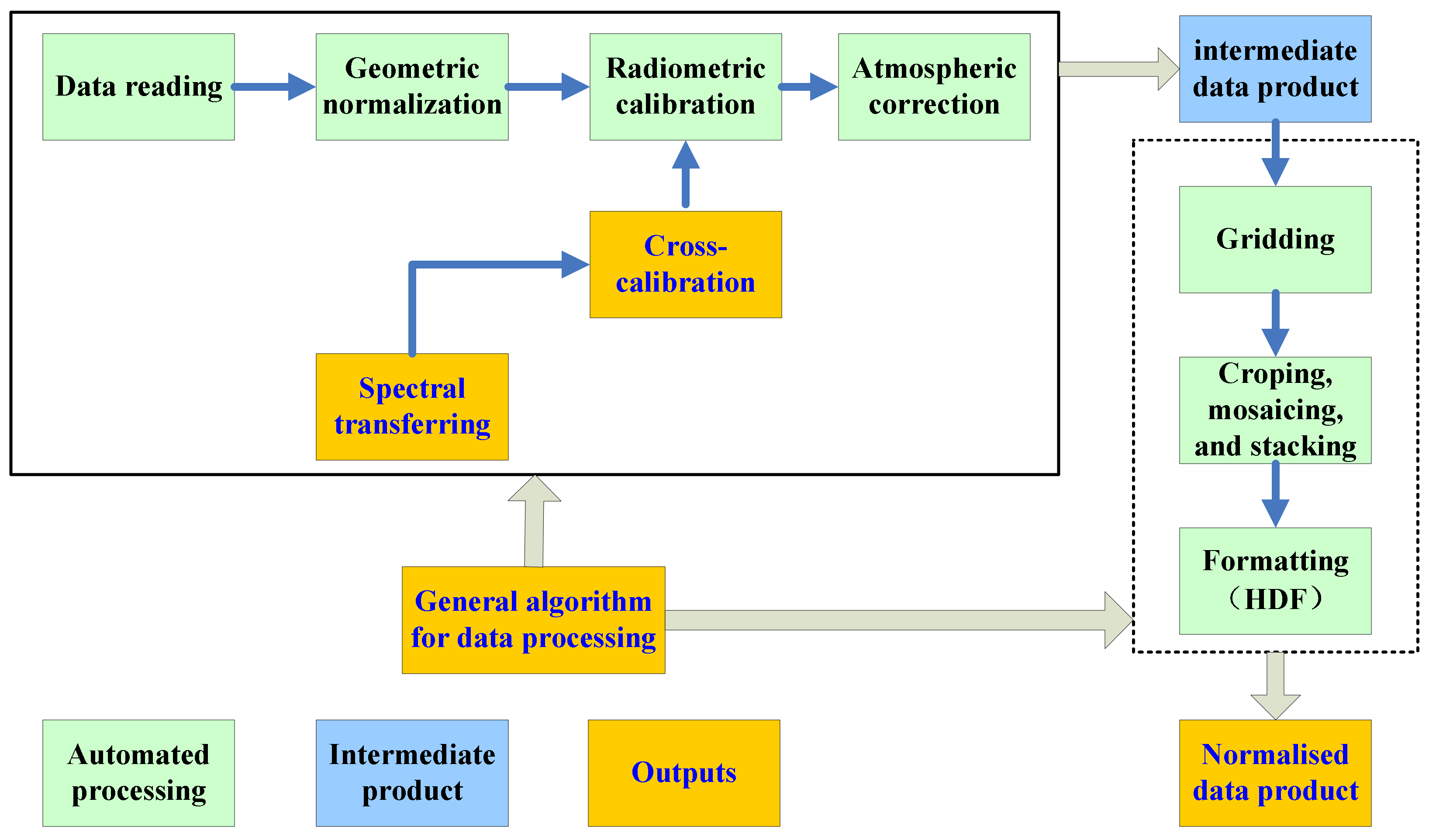
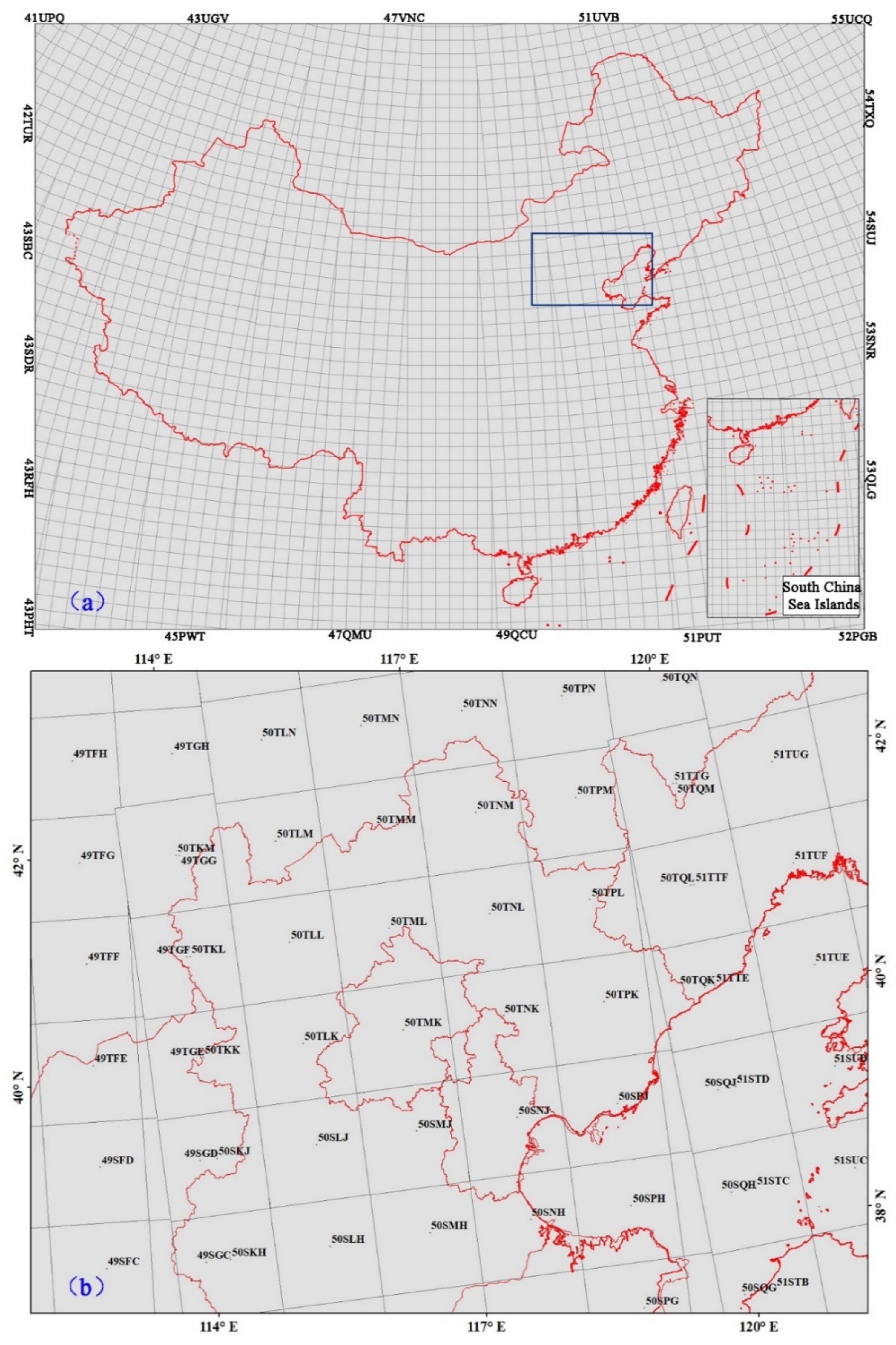
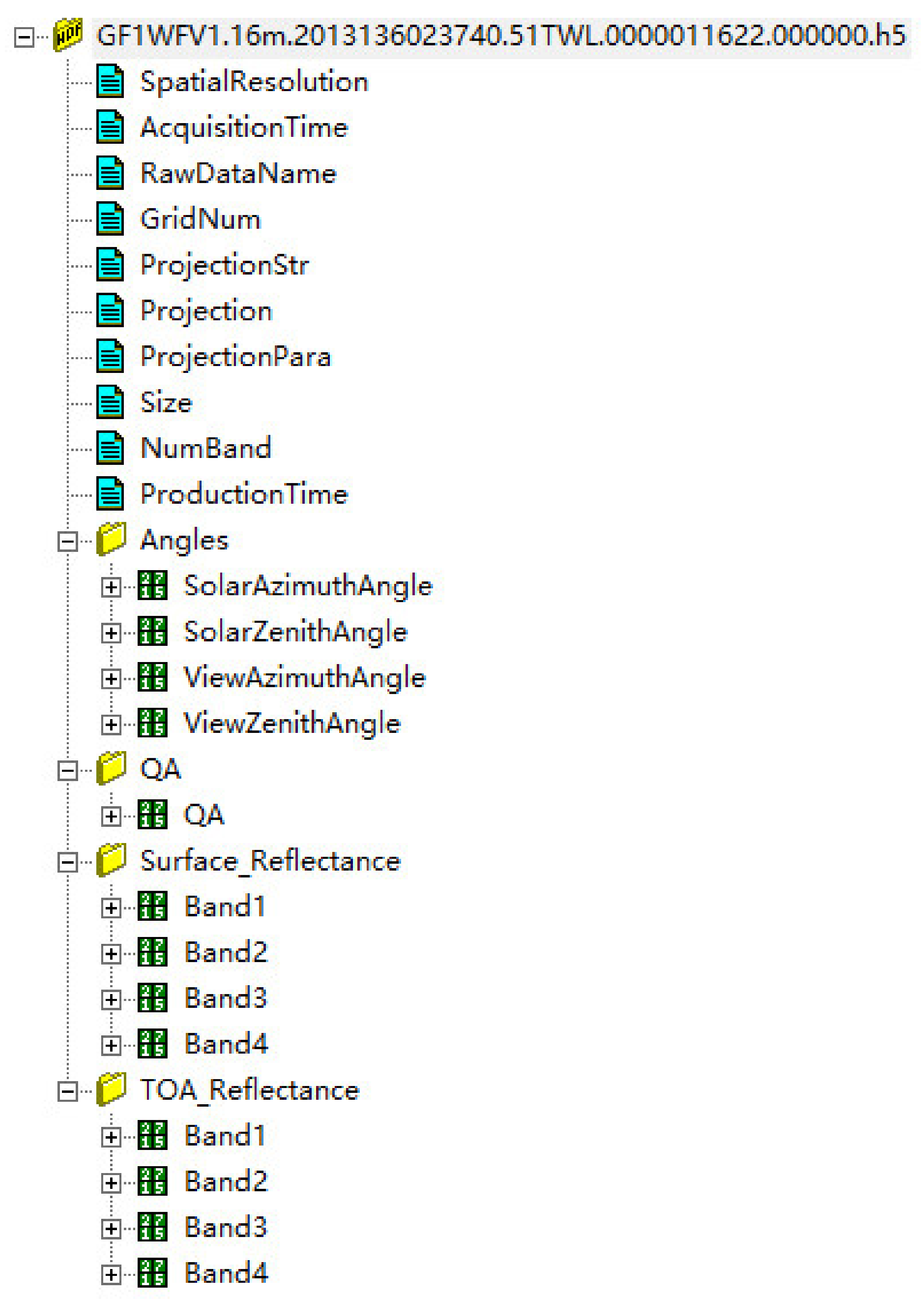
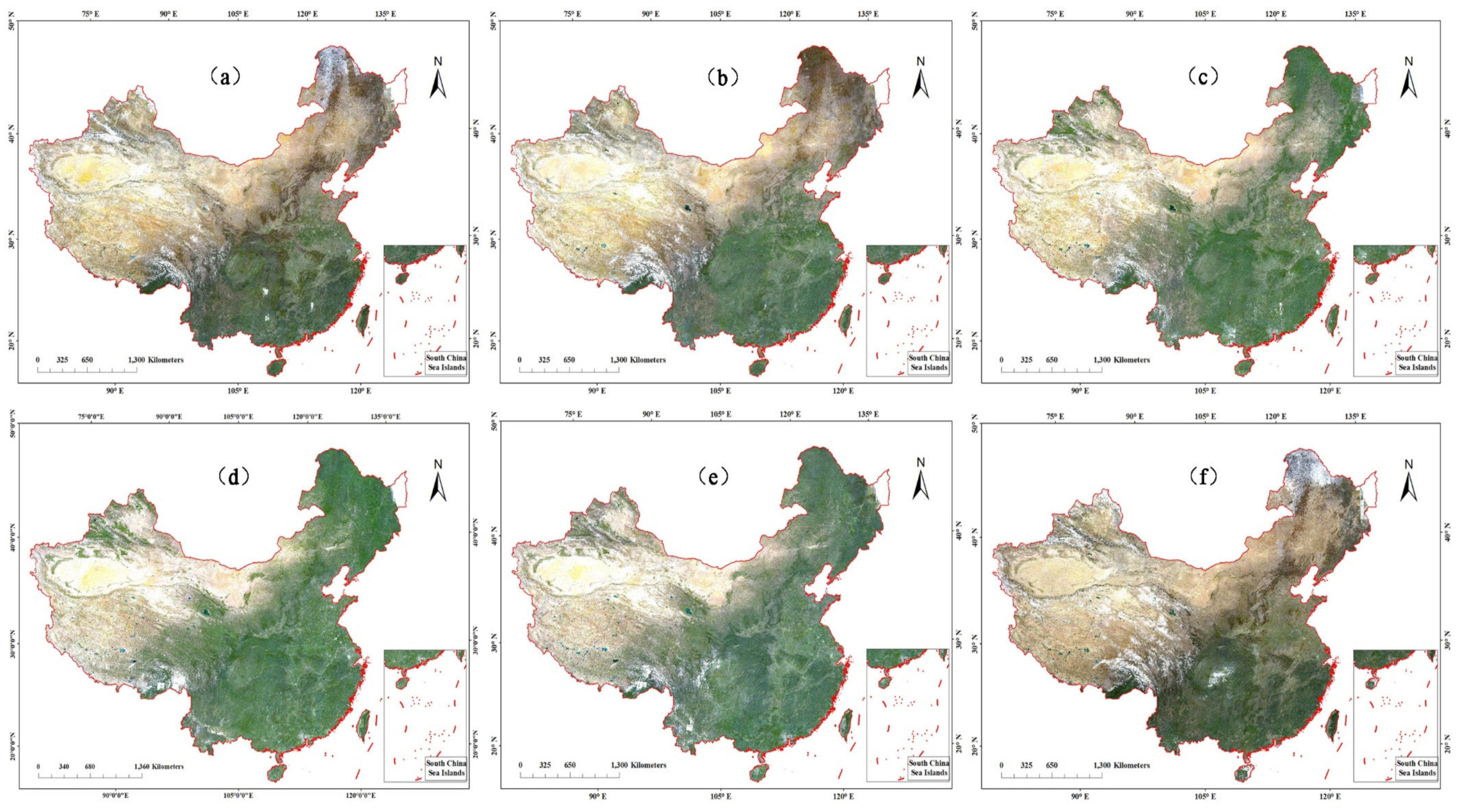
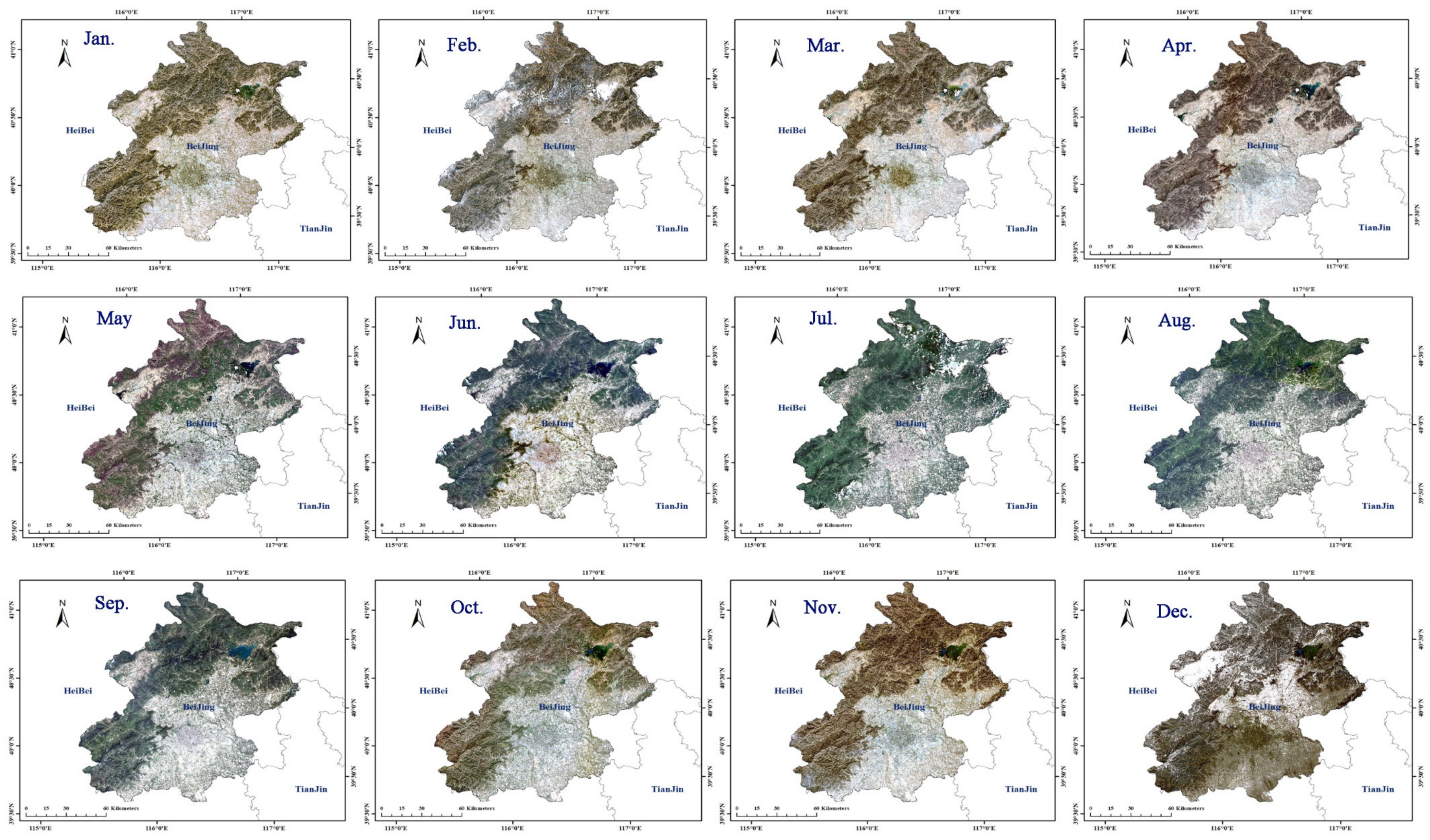
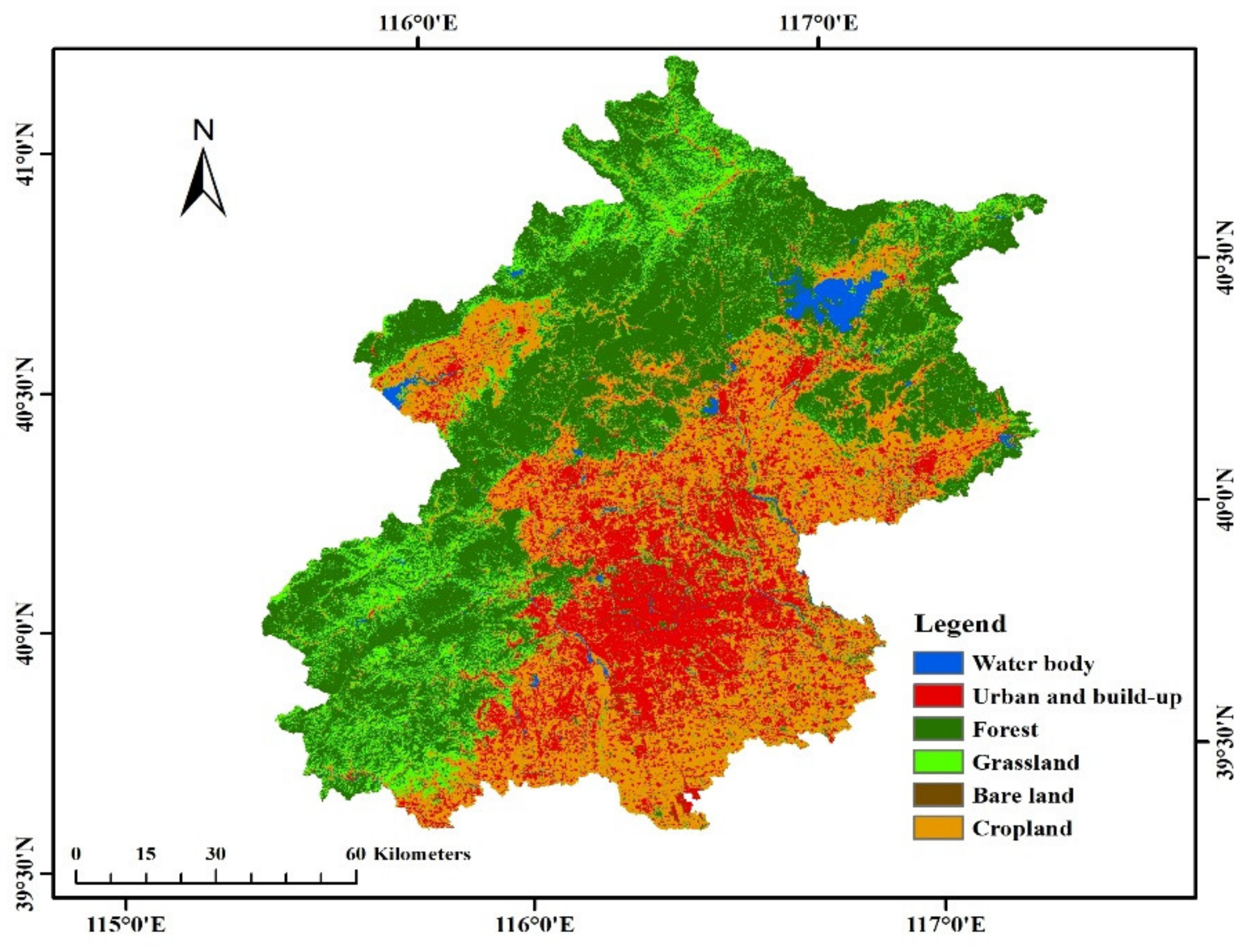
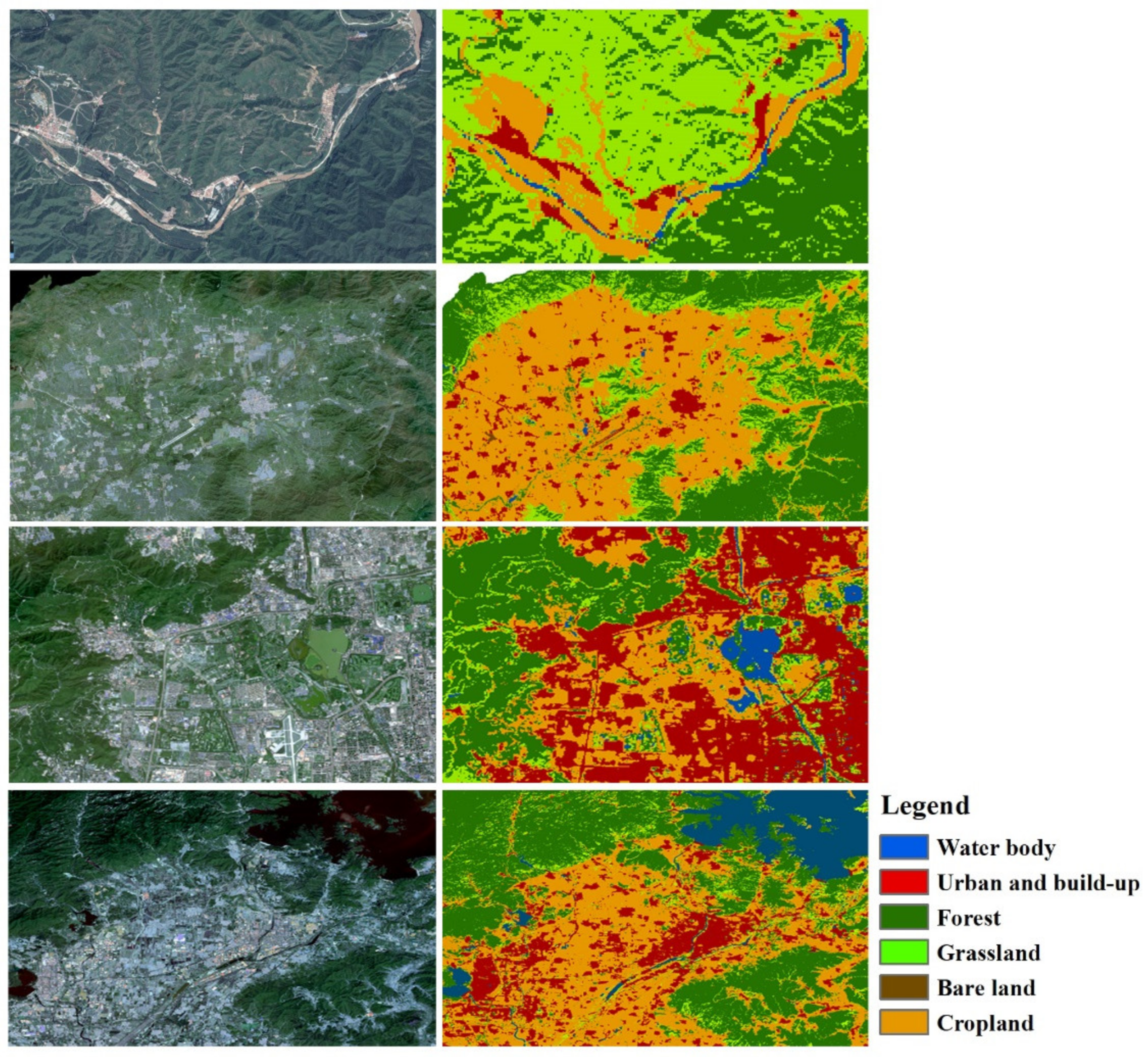
| Sensor(s) | Platform(s) | Spatial Resolution | Swath | Spectra | Launching Year |
|---|---|---|---|---|---|
| 2 CCDs | HJ1/A | 30m | 700km (2 cams) | VIS, NIR | 2008 |
| 2 CCDs | HJ1/B | 30m | 700km (2 cams) | VIS, NIR | 2008 |
| 4 WFVs | GF1 | 16m | 800km (4 cams) | VIS, NIR | 2013 |
| 1 WFV | GF6 | 16m | 800km | DB, VIS, NIR, Red edge | 2018 |
| 1 WFV | HJ2/A | 16m | 800km | DB, VIS, NIR, Red edge | 2020 |
| 1 WFV | HJ2/B | 16m | 800km | DB, VIS, NIR, Red edge | 2020 |
| Image No | 1 | 2 | 3 | 4 | 5 | 6 | 7 | 8 | 9 | 10 | |
|---|---|---|---|---|---|---|---|---|---|---|---|
| Sensor | |||||||||||
| GF1-WFV | 1.9 | 1.8 | 2.3 | 1.8 | 1.0 | 1.4 | 2.2 | 1.7 | 2.2 | 1.0 | |
| Sentinel2-MSI | 0.7 | 0.7 | 1.0 | 0.6 | 0.5 | 0.8 | 0.7 | 0.9 | 1.1 | 0.6 | |
| Band Name | Data Type | Units | Valid Range | Fill Value | Saturated Value | Scale Factor |
|---|---|---|---|---|---|---|
| Solar Zenith | INT 16 | Degree | −9000~9000 | −32,768 | NA | 0.01 |
| Solar Azimuth | INT 16 | Degree | −18,000~180,000 | −32,768 | NA | 0.01 |
| Viewing Zenith | INT 16 | Degree | −9000~9000 | −32,768 | NA | 0.01 |
| Viewing Azimuth | INT 16 | Degree | −18,000~180,000 | −32,768 | NA | 0.01 |
| Band Name | Data Type | Units | Valid Range | Fill Value | Saturated Value | Scale Factor |
|---|---|---|---|---|---|---|
| Band n TOA reflectance | INT 16 | -- | 0~10,000 | −9999 | 20,000 | 0.0001 |
| Bit | Interpretation |
|---|---|
| 0 | Fill |
| 1 | Clear |
| 2, 3 | Aerosol opacity; 00 =low (<0.5); 01 = Medium (<1.0); 10 = High (<2.0); 11 = Very High (>=2.0) |
| 4 | Cloud |
| 5 | Possibly cloud |
| 6 | Cloud shadow |
| 7 | Possibly cloud shadow |
| Type | Water Body | Urban Buildup | Grassland | Bare Land | Cropland |
|---|---|---|---|---|---|
| Water body | 151 | 1 | 1 | 0 | 1 |
| Urban buildup | 1 | 574 | 0 | 12 | 4 |
| Forest | 0 | 0 | 475 | 0 | 12 |
| Grassland | 0 | 3 | 2 | 2 | 21 |
| Bare land | 0 | 38 | 0 | 63 | 0 |
| Cropland | 2 | 14 | 10 | 1 | 484 |
Publisher’s Note: MDPI stays neutral with regard to jurisdictional claims in published maps and institutional affiliations. |
© 2021 by the authors. Licensee MDPI, Basel, Switzerland. This article is an open access article distributed under the terms and conditions of the Creative Commons Attribution (CC BY) license (https://creativecommons.org/licenses/by/4.0/).
Share and Cite
Zhong, B.; Yang, A.; Liu, Q.; Wu, S.; Shan, X.; Mu, X.; Hu, L.; Wu, J. Analysis Ready Data of the Chinese GaoFen Satellite Data. Remote Sens. 2021, 13, 1709. https://doi.org/10.3390/rs13091709
Zhong B, Yang A, Liu Q, Wu S, Shan X, Mu X, Hu L, Wu J. Analysis Ready Data of the Chinese GaoFen Satellite Data. Remote Sensing. 2021; 13(9):1709. https://doi.org/10.3390/rs13091709
Chicago/Turabian StyleZhong, Bo, Aixia Yang, Qinhuo Liu, Shanlong Wu, Xiaojun Shan, Xihan Mu, Longfei Hu, and Junjun Wu. 2021. "Analysis Ready Data of the Chinese GaoFen Satellite Data" Remote Sensing 13, no. 9: 1709. https://doi.org/10.3390/rs13091709








